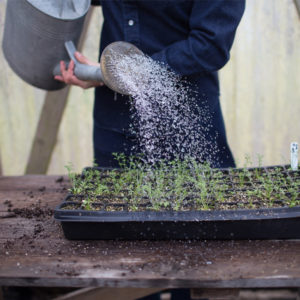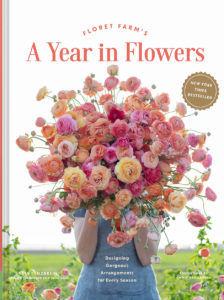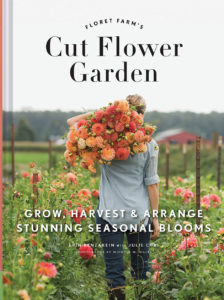We’ve spent the last 15 years writing, filming, and sharing as much as we possibly can about gardening, growing cut flowers, and flower arranging. We have a tremendous library of resources that we’ve created and I thought it would be helpful to give you an overview of where you can find the answers to all of your growing-related questions.
After reading through all of these resources, if you still don’t find what you’re looking for, we probably haven’t written about it yet, which is hard to believe! You’re welcome to leave your question in the comments section below and we’ll be sure to consider it for a future resource.
The first part of this post is dedicated to giving you an overview of the different resources that we’ve created, and the second part is dedicated to answering some of the most common gardening questions that we get each week.
OUR FULL RESOURCE LIBRARY
Floret Books
My first book, Floret Farm’s Cut Flower Garden: Grow, Harvest & Arrange Stunning Seasonal Blooms, covers everything you need to know about growing flowers on a small scale and is the perfect jumping-off point for beginning gardeners. It includes detailed growing instructions for more than 175 different flower varieties and is overflowing with so many beautiful photos.
My second book, Floret Farm’s A Year in Flowers: Designing Gorgeous Arrangements for Every Season, picks up where Cut Flower Garden left off and teaches you how to create beautiful arrangements using flowers from your garden or those grown close to home any time of the year.
And finally, my third book, Floret Farm’s Discovering Dahlias: A Guide to Growing and Arranging Magnificent Blooms, does a deep dive into one of the most beloved cut flowers—dahlias. In addition to sharing all of my secrets to successfully growing dahlias, this book also features 360 of my very favorite varieties organized by color and also includes a chapter on breeding your own new dahlias, plus how to save your seed.
Over on the Floret Books page, you can watch a short video that Chris and I filmed about each book.
Mini Courses
Throughout the year, we offer a series of video tutorials called Mini Courses which demonstrate the techniques we use to grow and harvest flowers on a small scale. These online classes are free, but registration is required. Visit our Workshops page to sign up for the Mini Course that’s currently available.
You can check our Resources page to see what Mini Course is currently available.
Floret Online Workshop
Each year we host the Floret Online Workshop, a 6-week intensive online course that covers everything I’ve learned about growing cut flowers and building a successful flower business on a small scale.
Registration for the Floret Online Workshop opens in the fall and the class runs January through mid-February. You can learn more about the workshop and join the waitlist here.
Online Resources & The Floret Library
The resources section of our website is overflowing with photo-filled tutorials on dozens of topics, including soil preparation, seed starting, variety selection, and so much more.
While you’re there, be sure to check out the Floret Library, which includes more than 1,500 unique cut flower varieties that have all been grown and tested here on our farm. You can search the library in a number of different ways—by plant collection, by color, by form, or by special features.
Floret Blog
In the early days of Floret, I decided to start a blog in an effort to become a better writer. It’s hard to believe just how far it’s come since my first post way back in 2006! The Floret Blog takes you behind the scenes here on the farm and is filled with hundreds of photo-filled stories about what I’ve learned along the way.
Documentary Television Series
In 2021, season 1 of Growing Floret, a four-part documentary series about our farm, debuted on the Magnolia Network. Each episode is centered around a specific season and explores what it takes to grow a heart-centered, creative business. After receiving two Emmy nominations for “Outstanding Cinematography” and “Outstanding Lifestyle Program” we began filming a second season, which premiered in the spring of 2023. For all the details about this project and how to watch, visit our show page to learn more.
COMMON GROWING-RELATED QUESTIONS
NEW TO FLOWER GROWING
I’m new to gardening. What varieties should I start with?
If you’re feeling a little overwhelmed with all of the choices available, we’ve put together a list of the best flower varieties by category depending on your growing needs. This list includes the best varieties for hot climates, cold climates, attracting pollinators, those suitable for containers, and even a few recommendations for shade. You can download it here.
I want to save my seeds but don’t know where to start. Do you have any advice?
Very little information about seed saving exists at this time. We are deep in the throes of documenting all of the processes that we use here at the farm related to seed saving. If this is a topic you’re interested in, be sure to sign up for our newsletter where we will be sharing progress updates.
In the meantime, be sure to check out Dawn Creek Farm (sign up for her newsletter for seed-saving tips) and Blomma Flower Farm has some wonderful how-to videos on Instagram.
If you have a copy of Discovering Dahlias, you can find seed-saving instructions starting on page 100.
CLIMATE-RELATED ADVICE
I am growing in a hot climate and I’m trying to figure out what varieties will do best here. What do you recommend?
We have a resource called Heat-loving Flowers & Foliage that covers all of the best varieties for hot climates that can be grown from seed. All of the varieties featured in it are suitable for beginning growers too!
If you’re looking for some inspiring flower growers to follow that are growing in hot climates, be sure to check out 3 Porch Farm in Georgia, FarmGal Flowers in Florida, and La Musa de las Flores in Mexico.
I’m confused when it comes to hardy annuals and I’m not sure if I should start them in the fall or in the spring. Help!
Hardy annuals are prized for their ability to withstand cold temperatures and are some of the first seed-grown flowers to bloom in late spring and early summer. We have an entire resource called Easy-to-grow Hardy Annuals dedicated to these hardworking flowers.
If you want to do a deep dive into this plant group, Lisa Mason Ziegler wrote a book all about them called Cool Flowers: How to Grow and Enjoy Long-Blooming Hardy Annual Flowers Using Cool Weather Techniques.
I don’t have any ground to grow in and I’m wondering what cut flower varieties are suitable for pots and containers?
Most cut flowers get too big to grow in containers, but there are a handful of compact varieties (that can be grown from seed) that we recommend for small spaces and pots. You can find the list here.
Small pots (especially terracotta) dry out very quickly so try to use the largest container you can get your hands on.
Sarah Raven’s 2021 book A Year Full of Flowers: Growing for all seasons includes lots of beautiful examples and information about growing flowers in containers, including bulbs, perennials, and more.
Claus Dalby’s 2022 book Containers in the Garden is filled with creative ideas for small garden spaces. It is one of the best I’ve seen on container gardening and is packed with stunning displays of texture and color. If you’re pressed for garden space, you’ll definitely want to pick up a copy.
I don’t have any sun in my garden. Do you have recommendations for flowers that do well in the shade?
While most cut flower varieties need at least 6 to 8 hours of full sun each day to thrive, there are a handful of varieties (that can be grown from seed) that are suitable for some degree of shade. You can find the list here. There are also some wonderful perennials that you might want to consider including, astilbe, astrantia, bleeding heart, columbine, ferns, hellebores, heuchera, Japanese anemones, lady’s mantle, and Solomon’s seal.
What are some of your favorite seed companies?
For a full list of our favorite domestic and international seed companies, be sure to read our blog post Floret’s Favorite Specialty Seed Sources.
How many flowers/bouquets will one packet of seeds produce?
Typically a packet includes between 25 and 100 seeds depending on the variety.
It’s impossible to predict exactly how many flowers you can get from each plant because there are so many factors at play, including weather, growing conditions, and the varieties’ growth habit.
When it comes to planning your garden, seed-grown varieties can be organized into three main categories: cut-and-come-again, medium producers, and one-hit wonders. You can learn about each of these groups and what kind of harvest you can expect in our blog post Succession Sowing: How to Keep the Harvest Going All Season Long.
SEED-STARTING QUESTIONS
I am new to gardening and have never grown seeds before. Where should I start?
To answer all of these questions and more we created our Winter Mini Course. In it, I show you everything you need to know to grow cut flowers from seed. Be sure to sign up for our newsletter to be notified when this course is available.
You can also find step-by-step instructions in our Starting Flowers from Seed resource and in the first chapter of Cut Flower Garden.
My sweet pea seeds aren’t sprouting. What did I do wrong?
Sweet peas are notoriously slow to germinate, especially the Chloranthus variety, which can sometimes take over a month to sprout. For step-by-step growing instructions, check out our How to Grow Sweet Peas resource.
DAHLIA GROWING
I see that you don’t sell dahlias anymore. Where do you recommend that I buy tubers?
For a list of our favorite sources, be sure to check out our Recommended Dahlia Sources blog post.
I have so many questions about dahlias. When do I dig them up? Do you have to wait to wash and divide dahlias until the winter or can I do it right away? How do I spot the eyes? What’s the best way to store them so they don’t shrivel?
To answer all of these questions and more we created our Fall Mini Course. In it, I show you everything you need to know to successfully dig, divide, and store dahlias for an abundance of blooms year after year. Be sure to sign up for our newsletter to be notified when this course is available.
I live in a hot or humid climate. Can I still grow dahlias?
Dahlias can often struggle to thrive in extreme climates (like Florida, Hawaii, Texas …) but it is possible to grow them and there are a handful of wonderful growers that you should follow to learn more: 3 Porch Farm in Georgia, FarmGal Flowers in Florida, and La Musa de las Flores in Mexico.
The Dahlia Society of Georgia has a big list of Heat Tolerant Dahlias for Southern Gardens that might be helpful when it comes to variety selection.
PLANT & BULB SOURCES
Do you sell tulips, daffodils, chrysanthemums, peonies, or roses? If not, where do you recommend I buy plants from?
You can find all of our favorite sources for trees, shrubs, perennials, and bulbs here. The nurseries that we share are all ones that we’ve worked with for many years and highly recommend.
SUPPLIES
Where do you get your paper flower sleeves, black buckets, and flower food?
For a full list of all of my favorite flower arranging and packaging supplies and where to get them, be sure to check out A Year in Flowers.
Where did you get your cute little seed-starting greenhouse?
Over the years we have built nearly 40 hoop houses and greenhouses in half a dozen different styles, and each one has its pros and cons. This past year we discovered Farmers Friend, and I am so impressed with all of the innovative work they are doing to help small-scale growers succeed when it comes to season extension and production.
We recently purchased a 14 by 50 ft (4 by 15 m) Gothic Pro tunnel kit from them and I can’t say enough good things about it. The hoops are pre-bent and all the supplies you’ll need are included (along with great instructional videos) so it’s super quick and easy to assemble. It’s a perfect size for a small farm or big backyard.
Where do you get your flower support netting and those metal hoops you use in the field?
For low tunnels, also known as caterpillar tunnels, we bend our own hoops using 10 ft galvanized ½-in EMT conduit that we get from the hardware store. We bend the conduit using Johnny’s Selected Seeds 4 ft Low Tunnel Hoop Bender.
The white flower netting that we use in the field to support plants is 48 in wide Hortonova netting from Johnny’s Selected Seeds. It can also be used vertically for trellising sweet peas and other vines.
Where do you get your black bulb crates?
When you order bulbs in large quantities (wholesale) they are delivered in these heavy-duty black plastic bulb crates. If you have any bulb farms in your area or large nurseries, sometimes they sell their extras. If you are looking for them to store your dahlia tubers in, you can also use plastic milk crates or vented vegetable harvesting totes.
PESTS, DISEASE & FERTILITY
How do you deal with slugs, snails, aphids, powdery mildew…?
Here at Floret, we practice organic farming and only use products that are OMRI certified and take a pretty laid-back approach when it comes to pests and disease. We like to focus on growing the healthiest plants we possibly can because we’ve found that healthy plants have fewer pests and less disease pressure. To read more about how we prepare our growing beds be sure to read our Soil Preparation resource.
We also use compost tea as a foliar fertilizer for many of our field crops. We have two professional-grade brewing systems that we got from Growing Solutions, and while they were quite the investment, they have been in active use for many years and are the backbone of our fertility program.
When it comes to brewing tea, it’s important to source very high-grade compost—not the same type you apply to your garden beds. We buy our tea-grade compost from Sound Horticulture. We apply the tea both through our drip irrigation system and when plants are young, we spray their leaves with it using a battery-powered backpack sprayer.
Arbico Organics is a great resource for organic pesticides, fungicides, and beneficial insects. They have a fantastic website and catalog that we reference often.
For powdery mildew, we use a combination of Milstop and Cease which we get from Arbico.
For slugs, snails, and earwigs, we use Sluggo Plus. And for aphids (inside a greenhouse) we use beneficial insects like lacewing larvae and outdoors (if an infestation gets out of control), we will spray them with Safer Soap.
DEER, RABBITS & OTHER CRITTERS
I have a major problem with deer. Are there any deer-resistant flower varieties that I can grow or do you know the best way to protect my plants from them?
Here at Floret, we have only recently started to see deer around our area so we don’t have any personal experience or advice to offer just yet. Many of our customers have recommended a book called Deer-Resistant Design: Fence-free Gardens that Thrive Despite the Deer by Karen Chapman.
If you have ANY resources that you’d recommend for other gardeners dealing with deer, please leave them in the comments below!
I have trouble with voles eating my tulip bulbs. What should I do?
We have trouble with voles eating our bulbs in the greenhouse and have found that trapping them using the method that Eliot Coleman detailed in his book The Winter Harvest Handbook: Year Round Vegetable Production Using Deep-Organic Techniques and Unheated Greenhouses has been the most successful. You can find videos and plans online.
Please note: If your comment doesn’t show up right away, sit tight; we have a spam filter that requires us to approve comments before they are published.
Floret only lists companies and products that we love, use, and recommend. All opinions expressed here are our own and Floret does not offer sponsored content or accept money for editorial reviews. If you buy something using the retail links in this post, Floret may receive a small commission. Thank you for your support!







Nancy on
I saw your earlier video post regarding seed starting soil comparisons. You had developed a soil that produced incredible seedlings. Have you ever posted the recipe for this seed starting soil? I am anxious to hear because my seedling soil last year was terrible! Thanks so much.